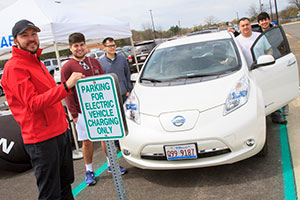充电50英里,你会去哪里?
The worry of running out of power (range anxiety) steers drivers away from considering electric vehicles (EVs). EVs have a range of 100 to 250 miles on a single charge, and more than 80 percent of round-trip daily commutes in the U.S. are 50 miles or less. The math favors this emission-free technology.
 Charging an EV costs less than the price of gasoline for the same mileage. Spending less on fuel leaves you with more money to go out to dinner, visit a museum or make home improvements. This spending on local services helps our economy, whereas the majority of every dollar spent on gasoline leaves the state to pay for oil extraction and refining.
Charging an EV costs less than the price of gasoline for the same mileage. Spending less on fuel leaves you with more money to go out to dinner, visit a museum or make home improvements. This spending on local services helps our economy, whereas the majority of every dollar spent on gasoline leaves the state to pay for oil extraction and refining.
If just 5,000 cars in Lake County were electric vehicles, greenhouse gas emissions would be reduced by the equivalent of more than 300 tanker trucks of gasoline.
Drivers in the U.S. tend to keep their cars for at least eight years. EV batteries have proven to last longer than that, eliminating another consumer concern.
An electric vehicle can take you to so many places in the region on just a single charge!
Benefits of the Electronic Vehicle Charging Station
At the College
At CLC, we’re doing our part to reduce commute-generated emissions with carpools, electric vehicle charging stations, ample bike parking and the Pace bus transportation hub. Traveling between the Grayslake and Lakeshore campuses? Spending 25 minutes on the bus can give you a chance to read or relax.

In the Community
Walking, biking, taking mass transit, and driving hybrid and electric vehicles all reduce carbon emissions. Try your own ‘living lab’ experiment by keeping a travel log for one week, noting where you go and how far you travel. You may discover opportunities to carpool or bike, or that an EV is a viable option.
Around the World
中国正在资助新能源汽车的研究,并要求汽车制造商在2025年前实现54英里/加仑以上的燃油效率。印度有一项政策,到2030年只销售电动汽车。这只是国际社会如何利用电动汽车的力量来促进交通、刺激经济发展和减少排放的两个例子。